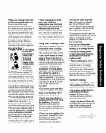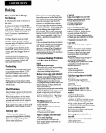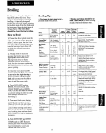
-.
IMPORTANT SAFETY INSTRUCTIONS
(continued)
Read all instructions before using this appliance.
l
Use only dry pot holders-
moist or damp pot holders on hot
surfaces may result in burns from
steam. Do not let pot holders
come near open flames when
lifting utensils. Do not use a towel
or other bulky cloth in place of a
pot holder.
l
To minimize the possibility
of burns, ignition of flammable
materials and spillage, turn the
cookware handles toward the side
or back of the cooking center
without extending over adjacent
burners.
l
Always turn surface burner to
OFF before removing utensil.
l
Carefully watch foods being
fried at HI flame setting.
l
Never block the vents (air
openings) of the cooking center.
They provide the air inlet and
outlet which is necessary for the
cooking center to operate properly
with correct combustion.
l
Do not use a wok on the
cooking surface if the wok has a
rougd metal ring which is
placed over the burner grate to
support the wok. This ring acts
as a heat trap which may damage
the burner grate and burner head.
Also, it may cause the burner to
work improperly. This may cause
a carbon monoxide level above
that allowed by current standards,
resulting in a health hazard.
l
Foods for frying should be as
dry as possible. Frost on frozen
foods or moisture on fresh foods
can cause hot fat to bubble up and
over sides of pan.
l
Use least possible amount of
fat for effective shallow or deep-
fat frying. Filling the pan too full
of fat can cause spillovers when
food is added.
l
If a combination of oils or
fats will be used in frying, stir
together before heating, or as fats
melt slowly.
l
Always heat fat slowly, and
watch as it heats.
l
Use deep fat thermometer
whenever possible to prevent
overheating fat beyond the
smoking point.
l
Use proper pan size-Avoid
pans that are unstable or easily
tipped. Select utensils having flat
bottoms large enough to properly
contain food avoiding boilovers
and spillovers, and large enough
to cover burner grate. This will
both save cleaning and prevent
hazardous accumulations of food,
since heavy spattering or spillovers
left on cooking center can ignite.
Use pans with handles that can be
easily grasped and remain cool.
l
Use only glass cookware that
is recommended for use on gas
burners.
l
Keep all plastics away from
top burners.
l
To avoid the possibility of a
burn, always be certain that the
controls for all burners are at
OFF position and all grates are
cool before attempting to remove
a grate.
l
When flaming foods under
the hood, turn the fan off. The
fan, if operating, may spread
the flame.
l
If cooking center is located
near a window, do not use long
curtains which could blow over
the top burners and create a fire
hazard.
l
If you smell gas, turn off the
gas to the cooking center and call
a qualified service technician.
Never use an open flame to locate
a leak.
4
Baking, Broiling and
Roasting
l
Do not use oven for a storage
area.
l
Stand away from the cooking
center when opening the door of
a hot oven, The hot air or steam
which escapes can cause burns
to hands, face and/or eyes.
l
Don’t heat unopened food
containers in the oven. Pressure
could build up and the container
could burst causing an injury.
l
Don’t use aluminum foil
anywhere in the oven except as
described in this book. Misuse
could result in a fire hazard or
damage to the cooking center.
l
Use only glass cookware that
is recommended for use in gas
ovens.
l
When using cooking or
roasting bags in oven, follow
the manufacturer’s directions.
l
Always remove broiler pan
from the oven as soon as you
finish broiling. Grease left in the
pan can catch fire if oven is used
without removing the grease from
the broiler pan.
l
When broiling, if meat is too
close to the flame, the fat may
ignite. Trim excess fat to prevent
excessive flare-ups.
l
Make sure broiler pan is in
place correctly to reduce the
possibility of grease fires.
l
If you should have a grease
fire in the broiler pan, turn off
oven, and keep oven door closed
to contain fire until it burns out.


















